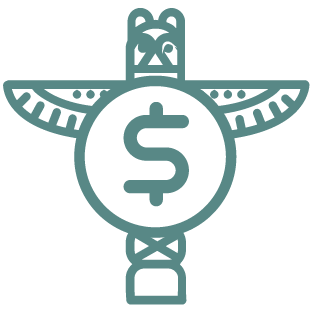In a guest essay, Allan Clarke explores ways Canada can tap First Nations’ potential to advance Canada’s green growth
Key Points
 Federal government’s 2023 budget commitments will empower Indigenous Peoples to play a vital role in helping Canada achieve its Net Zero goals.
Federal government’s 2023 budget commitments will empower Indigenous Peoples to play a vital role in helping Canada achieve its Net Zero goals. Government’s financial support for Indigenous investment in major projects is critical in achieving economic reconciliation.
Government’s financial support for Indigenous investment in major projects is critical in achieving economic reconciliation. Made-for-Canada tools could include loan guarantee programs, capital-raising vehicles, and credit risk management to hone Indigenous potential and embed their capital and skillsets in green economic and community development projects.
Made-for-Canada tools could include loan guarantee programs, capital-raising vehicles, and credit risk management to hone Indigenous potential and embed their capital and skillsets in green economic and community development projects. Long-term and sustainable access to a predictable capital stream can only be achieved through structural changes in fiscal and taxation frameworks.
Long-term and sustainable access to a predictable capital stream can only be achieved through structural changes in fiscal and taxation frameworks. Indigenous Groups can lead in advancing Canada’s Critical Minerals Strategy—which is expected to play a pivotal role in fuelling the domestic and global low-carbon economy.
Indigenous Groups can lead in advancing Canada’s Critical Minerals Strategy—which is expected to play a pivotal role in fuelling the domestic and global low-carbon economy.
Indigenous Groups Emerge As A Net Zero Pillar In Budget 2023
In Budget 2023, the Government of Canada recognized “the world’s major economies are moving at an unprecedented pace to fight climate change, retool their economies, and build the net-zero industries of tomorrow.”
To keep up, Budget 2023 proposed several initiatives that were described as necessary “to build a thriving, sustainable made-in-Canada clean economy.”
Some notable budget highlights:
- Significant investments to accelerate the supply and transmission of clean electricity
- A refundable tax credit to support and accelerate clean electricity investment in Canada
- Prioritizing investments through the Canada Infrastructure Bank to support the building of major clean electricity and clean growth infrastructure projects
- Recapitalizing funding for the Smart Renewables and Electrification Pathways Program to support regional priorities and Indigenous-led projects.
At the same time, Ottawa recognized two fundamental challenges to the success of this effort.
First, large-scale, long-term investments are required to support the realignment of global supply chains and build a Net Zero future. And second, the recent passage of United States’ Inflation Reduction Act (IRA) poses a major challenge to Canada’s ability to compete in the industries that will drive the green economy.
To accelerate the completion of major projects required to drive the clean economy, the government intends to prioritize expediting major project reviews while maintaining strong regulatory standards.
The government also stated its commitment to further improving the quality and consistency of benefits that Indigenous communities derive from major projects in their territories, by advancing opportunities for Indigenous communities to participate as partners in major projects.
- Budget 2023 identified $8.7 million to support engagement with Indigenous partners, including Indigenous rights-holders, towards the development of a National Benefits-Sharing Framework.
- The Canada Infrastructure Bank is tasked with providing loans to Indigenous communities to support them in purchasing equity stakes in major projects in which the Bank is also investing.
Both initiatives will serve Canada’s effort to build the clean economy.
In the first case, meaningful implementation of the United Nations Declaration on the Rights of Indigenous Peoples (UNDRIP) in Canada requires a sharing of wealth and power. Article 26 of UNDRIP states that “Indigenous Peoples have the right to the lands, territories and resources which they have traditionally owned, occupied or otherwise used or acquired.”
A National Benefits-Sharing Framework could be an important step in implementing UNDRIP and achieving economic reconciliation.
Support from the Canada Infrastructure Bank to help Indigenous communities purchase equity stakes in major projects, while limited in scope, is another welcome development.
Making Capital Affordable
It’s a start, but more can be done. Here are three mutually beneficial ways Canada can unlock capital for Indigenous participation.
1. A More Comprehensive Loan Program
The greatest impediment to Indigenous participation in major projects is access to affordable capital.
The causes are well documented: a legal and regulatory environment that is unfavourable for economic and business development; historic and deliberate exclusion from exercising jurisdiction over traditional lands and resources; inequitable public investment in housing and infrastructure; lack of support for business growth; and a complex government funding regime.
According to the National Indigenous Economic Strategy: “While the effects of colonialism have been devastating to the social, physical, and mental health of our communities, one of its most nefarious objectives was the deliberate exclusion of Indigenous Peoples from sharing in the wealth of this country.”1
The principal instrument to achieve this nefarious objective is generally understood to be the anachronistic Indian Act, which regulates almost every aspect of community life on reserve for nearly 600,000 registered Indians.2 It defines who is an “Indian” and, among other matters, regulates band membership, band government, taxation, lands and resources, estates and money management.
While legislation and regulations in off-reserve contexts typically evolve and are updated over time, the Indian Act has largely been frozen in time, leaving on-reserve communities with outdated and paternalistic rules and procedures that have not kept pace with a modern economy.
Partly as a result of its fiduciary duty to Indigenous people, the federal government often acts in ways that hinder economic and business development on reserve. As a fiduciary, the Crown is required to protect the interests of First Nations and is liable if it fails to do so: witness the growing inventory of Specific Claims that deal with historic wrongs against First Nations.3
This slows down transactions considerably, as the Crown often acts in a manner designed to reduce potential liability for decisions over which it has ultimate authority under the Indian Act.
According to research conducted by Fiscal Realities, in its report Expanding Commercial Activity on Reserve Land, “as result of delays and a reluctance of the Crown to allow First Nations to share risk, First Nations are not only protected from bad deals but also lose many good ones.”4
Deployed prudently, loan guarantee programs similar to the ones in place in Alberta, Ontario and Saskatchewan, can help Indigenous communities overcome the impediments to economic development and barriers to economic inclusion that are the product of outmoded policy and legislation.
Most recently, the Alberta Indigenous Opportunities Corporation (AIOC) played a key role in the landmark agreement that resulted in 23 First Nations and Métis communities acquiring an 11.57% non-operating interest in seven Enbridge pipelines in northern Alberta (valued at $1.12 billion). In this case, the AOIC provided a loan guarantee that made the project a viable proposition for the Indigenous groups.
At the time, Indigenous leaders involved spoke passionately about impacts the stable source of long-term revenues generated by the partnership will have on their citizens and communities. Fort McKay Métis Nation president Ron Quintal said the agreement will mean the community can direct more money to education, infrastructure and housing.5
A federal loan guarantee program would facilitate equity participation by Indigenous communities in major projects, thereby advancing economic reconciliation by redressing past efforts at economic exclusion. It also furthers the implementation of UNDRIP by creating the conditions conducive to free, prior and informed consent, and support Indigenous communities in generating revenues that will be re-invested in Indigenous housing, education, health and other services that promote community well-being and better socio-economic outcomes.
2. Overcoming Development Barriers
Canada needs to take meaningful action on closing the infrastructure gap.
Longstanding under-investment in key infrastructure in First Nations communities has created immense economic, social and health inequities. While adequate infrastructure is vital to community health and well-being, the lack of infrastructure—housing, broadband, connectivity, transportation, energy, adequate water and wastewater treatment systems—is a serious barrier to economic development and an impediment to participation in major projects.
While investments announced in recent budgets represent a significant increase to historical levels of Indigenous infrastructure funding, they are still inadequate to substantially close the infrastructure gap.
New approaches and innovations are also required to more effectively deploy available federal funding. It’s generally accepted that the serious shortages of on-reserve housing and infrastructure cannot be addressed exclusively through the current “annual cash funding” model of federal funding. When inflation exceeds annual budget increases, less infrastructure is built each year even as the Indigenous population continues to grow. Alternatives must be contemplated.
The First Nations Fiscal Management Act and its institutions, including the First Nations Finance Authority, the First Nations Financial Management Board and the First Nations Infrastructure Institution, can be used to leverage long-term federal transfers to raise debt financing through the capital markets to build on-reserve infrastructure and housing.
Specifically, the First Nations Fiscal Management Act (FNFMA) provides First Nations with fiscal powers similar to those exercised by municipalities and other orders of government in the areas of real property taxation, financial management and access to capital. Promoting strong and accountable on-reserve taxation and financial management frameworks, and providing a mechanism to access pooled borrowing for infrastructure and other public works, has allowed the regime to demonstrate its value as an important instrument to promote economic development and support sustainable First Nations communities.
Since the issue of its first debenture in 2014, the First Nations Finance Authority has raised over $1.8 billion in the capital markets. This financing is used to construct housing and public infrastructure in First Nation communities. Today, more than 350 First Nations have joined the FNFMA, and 142 First Nations are now qualified borrowing members.
According to Closing the Infrastructure Gap by 2030: A Collaborative and Comprehensive Cost Report Identifying the Infrastructure Needs of Canada’s First Nations, published in 2022, $349.2 billion is required between now and 2030 to close the infrastructure gap in First Nations communities.6 The report—undoubtedly the most thorough, comprehensive and far-reaching assessment and costing of First Nations housing and infrastructure needs ever undertaken—outlines the capital and operations and maintenance costs to construct, repair and improve First Nations infrastructure and ensure its proper and on-going maintenance.
The report identifies major infrastructure requirements across a broad range of needs—often needs that are not typically funded by Indigenous Services Canada or other federal government departments. In addition to estimating costs associated with education, housing and public infrastructure, the report provided a comprehensive examination of the cost associated with all-season access roads, climate adaptation, meeting Net Zero carbon goals, connectivity and accessibility.
Building on the success of FNFMA, the government should allow First Nations to borrow against long-term federal transfers. This would ensure that more infrastructure and housing can be built now, in today’s dollars, and with higher standards for design, construction and maintenance than currently exists in government programs.
3. Forging A New Fiscal Relationship With Indigenous Peoples
Canada must fulfill its commitment to building a new fiscal relationship with Indigenous Peoples.
In 2019, the Joint Advisory Committee on Fiscal Relations released its interim report7 with wide-ranging recommendations on improving the Nation-to-Nation and Treaty-based fiscal relationships of First Nations and Canada. These recommendations included moving toward sufficient flexible and predictable funding, enhancing revenue generation opportunities, strengthening the institutions that support First Nations, new approaches to measuring for results, new fiscal and taxation powers, and the establishment of new fiscal institutions.
The fiscal powers, institutional structures and financial and administrative capacity associated with a new fiscal relationship are necessary pre-requisites to support successful and authentic partnerships with Indigenous communities in major projects. It’s a necessary step on the road to a clean economy that would ensure Indigenous governments have meaningful access to capital, including their own.
These recommendations are consistent with the government’s own stated positions. For example, Canada’s Critical Minerals Strategy was described by the Minister of Natural Resources as setting the stage for the “advancement of reconciliation with Indigenous Peoples.”8
The Critical Minerals Strategy will prioritize economic reconciliation, respect Aboriginal and Treaty rights and contribute to the socio-economic well-being of Indigenous communities. The strategy identifies strong, progressive relationships with First Nations, Inuit, and Métis peoples across Canada through early engagement, collaboration, and the development of mutually beneficial partnerships as key success factors.
The strategy also identifies systemic barriers to Indigenous participation and leadership in the sector, in addition to addressing economic, business, and community skills and capacity gaps. The blueprint also identifies the need for more Indigenous-led research and inclusion of traditional knowledge and inclusion in planning, and decision-making throughout the project lifecycle. It also rightfully cites lack of access to competitive capital for equity participation as a major impediment.
The implementation of a federal loan guarantee program would facilitate equity participation of Indigenous communities in major projects. Closing the infrastructure gap by employing innovative solutions would help address a long-standing impediment to creating the conditions for economic development in Indigenous communities, while complementing efforts to increase own-source revenues from participation in major projects and to establish a modern fiscal relationship between Canada and Indigenous governments.
These efforts would pay dividends—not to shareholders in private companies—but to citizens of Indigenous governments through new investments in housing, infrastructure, education, health care and facilities and other public works. All of which are sorely—and demonstrably—needed.
Contributors:
Lead Author: Allan Clarke, Consultant, Indigenous Issues
RBC Climate Action Institute
Myha Truong-Regan, Head of Climate Research
Yadullah Hussain, Managing Editor
Shiplu Talukder, Digital Publishing Specialist
Darren Chow, Senior Manager, Digital Media
Allan Clarke is an Ottawa-based consultant on Indigenous issues. He previously served more than 30 years in the Public Service of Canada, most recently as the Director General, Economic Research and Policy Development with the former Indigenous and Northern Affairs Canada. Allan has served on several not-for-profit boards, including Catalyste+, the Indigenous Screen Office, the John Howard Society (Ottawa), BookNet Canada and the Association for the Export of Canadian Books. He is Anishinaabe with family roots on the Wikwemikong Unceded Indian Reserve.
- https://niestrategy.ca/
- https://laws-lois.justice.gc.ca/eng/acts/i-5/
- https://services.aadnc-aandc.gc.ca/scbri_e/main/reportingcentre/external/externalreporting.aspx
- http://www.naedb-cndea.com/en/addressing-barriers/
- https://calgaryherald.com/opinion/columnists/varcoe-project-rocket-launches-with-1b-indigenous-ownership-stake-in-enbridge-pipelines
- https://www.afn.ca/wp-content/uploads/2022/12/22-11-17-SCA-Slides-for-SDWFNA-and-Closing-the-InfrastructureGap__.pptx
- https://www.afn.ca/wp-content/uploads/2019/11/Interim-Report-of-the-Joint-Advisory-Committee-on-Fiscal-Relations-Jun…4.pdf
- https://www.canada.ca/en/campaign/critical-minerals-in-canada/canadas-critical-minerals-strategy.html
This article is intended as general information only and is not to be relied upon as constituting legal, financial or other professional advice. A professional advisor should be consulted regarding your specific situation. Information presented is believed to be factual and up-to-date but we do not guarantee its accuracy and it should not be regarded as a complete analysis of the subjects discussed. All expressions of opinion reflect the judgment of the authors as of the date of publication and are subject to change. No endorsement of any third parties or their advice, opinions, information, products or services is expressly given or implied by Royal Bank of Canada or any of its affiliates.


 Learn More
Learn More